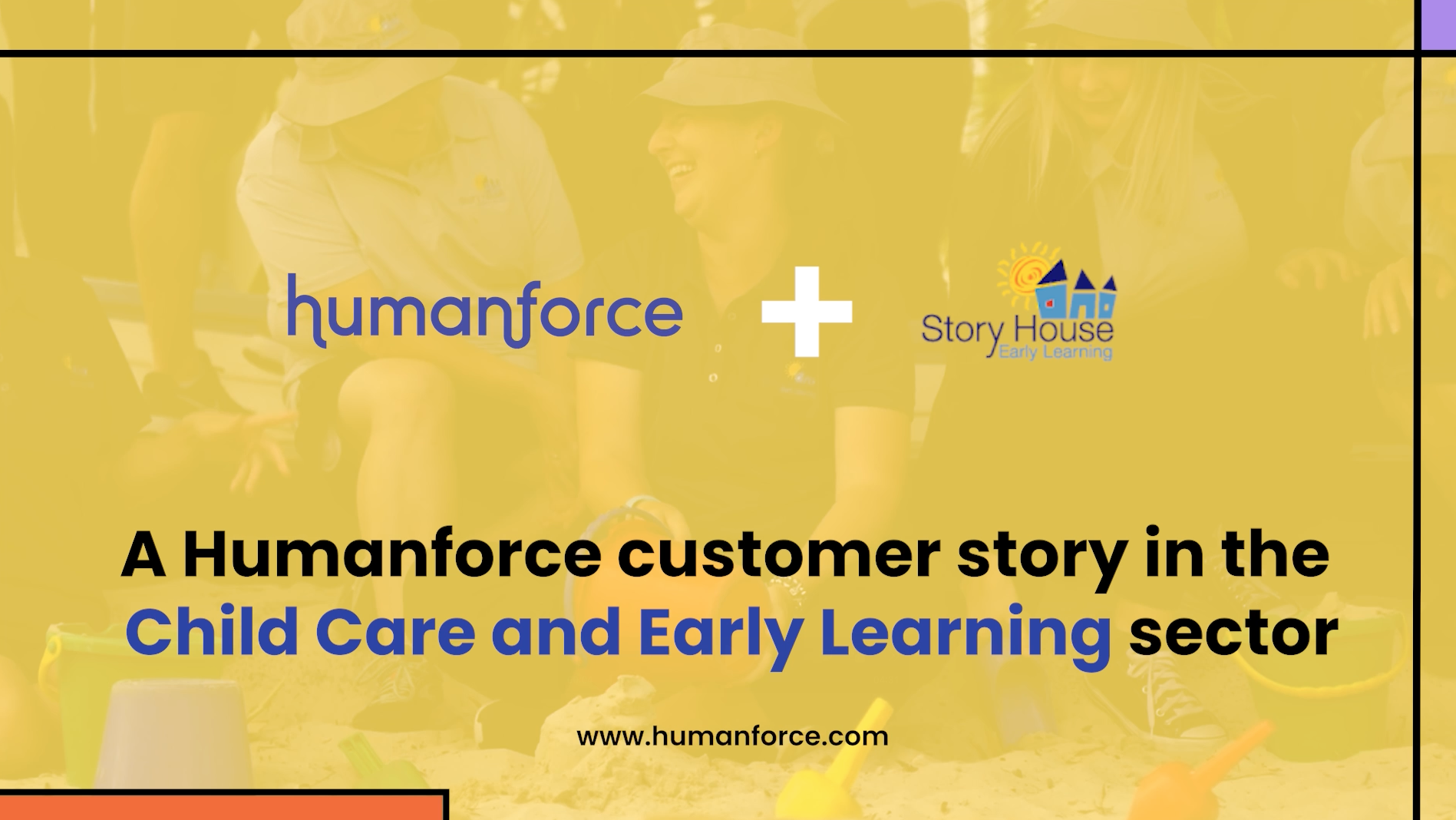- Our suite
Story House Early Learning
)
Key takeaways

Meet Story House Early Learning
Story House Early Learning is an early childhood education and care provider with services across Queensland, NSW and Victoria. With 50 centres and more than 1500 team members – known as ‘Story Housers’ – the company is constantly growing and evolving. What remains unwavering, however, is the Story House team’s commitment to caring for children.
Below, Kate Ludwig, Chief People Officer, shares her views on the people-related challenges facing her organisation, and how the Humanforce HCM suite has helped overcome these.

Challenges
The childcare & early learning industry has faced daunting talent challenges in recent years; employee burnout, low pay and a high administration burden have resulted in high employee turnover rates for many businesses in the sector.
Given that environment, a focal point for Ludwig when she joined Story House in 2021 was to improve the overall employee experience (EX) for Story Housers. To this end, her priority has been on supporting their health and wellbeing, reshaping and centralising core HR management processes, and reducing the admin burden for staff.
“Any systems or processes that we implement from our support office or the people & culture team needs to help free up administrative time so that our team members can focus on what their core role is, which is to care for children,” Ludwig says.
Before Humanforce was implemented, the company’s HR and workforce management data, systems and processes were handled in an ad-hoc manner across the business.
Ludwig knew that automating these processes and creating a centralised repository of employee data would improve overall operational efficiency and enhance the EX for a dispersed workforce.
“Central oversight of information is critical for me as a people & culture manager, to ensure I can properly understand what’s going on with our workforce and make decisions based on the feedback we’re receiving,” she says.

The solution: Why Humanforce?
When Ludwig joined Story House, the company was already using Humanforce platform; today, they rely on Humanforce Workforce Management, HR and Benefits.
Here’s a breakdown of the core aspects of the Humanforce suite that Story House relies on to deliver on critical business objectives, while delivering a positive employee experience:
1. Humanforce Benefits
Humanforce Benefits is accessible to employees through the Humanforce Thrive mobile app. Thrive provides financial wellbeing offerings including educational resources, savings tools, access to a percentage of earned wages ahead of payday, and a range of other benefits and tools for employees. Ludwig was drawn to the product because of Story House’s focus on employee safety and wellbeing.
“Humanforce Thrive was a good values alignment fit for us as a company,” she says. “Being able to give Story Housers access to their earned wage when they wanted, to provide tools to improve their financial literacy, to give them autonomy over their own finances and create an environment where they don’t need to access payday loans or credit cards, was a great fit for the company and our workforce.”
There was another essential element of Humanforce Thrive that appealed to Story House: being able to support any employee living in stressful circumstances. Ludwig explains:
“For us, Humanforce Thrive is also a safety tool. We’ve had instances with our mostly female workforce where they’ve unfortunately been living with domestic and family violence. These workers might have to make difficult decisions about their safety versus financial support. Humanforce Thrive is a tool they can use to discreetly access money that might get them into a safe environment. They can feel more comfortable and more confident that they have that access if and when they need it.
"Additionally, the convenience of issuing tasks from Humanforce HR to Story House-ers directly in their Thrive app, eliminates friction and the risk of the task getting lost in emails. Instead, employees get push notifications and can action their task (like completing a form or acknowledging a policy) right in the app." Ludwig states.

2. Humanforce Work App
Ludwig notes that in early education and childcare, managers wear multiple hats and need to juggle many tasks at once. She says the Humanforce Work App, which enables workers to check rosters, bid on shifts, apply for leave and clock in and out, and for managers to make approvals, make shift offers, update rosters and check attendance on-the-go, has made a huge difference to productivity.
“If a team member calls in sick, a manager can access the app, send a shift offer out to the casual pool of workers within that region, or else a permanent part-time team member who is not working that day, and they can fill the shift within seconds. That process creates a streamlined and efficient way for our managers to manage their day in a way that doesn’t create additional workload.”
For employees, it’s about empowerment. “The ability to self-serve and have greater transparency has been critical for our Story Housers,” Ludwig says. “Being able to access information about their roster and timesheet, to quickly sign into and out of work once they’re within the geofenced location, or to apply for leave without having to access difficult systems, means they can start their day focused on what’s important.”

3. Employee Engagement
Prior to Humanforce, Story House was not collecting – much less making decisions based upon – people-related data. One area that has benefitted the most has been the ability to track employee engagement accurately and easily. Ludwig says that surveys sent through the Employee Engagement solution get great response rates, and responses to exit surveys have increased from around 10% when a third-party platform was being used, to more than 40% today.
“We can use that feedback to make sure we’re continuously improving and that the strategic goals we’re setting as an organisation are aligned to what our people need and want,” she says.
4. Compliance Management/Qualifications Management
Childcare & early education is a heavily regulated industry with strict regulations about employee certifications and qualifications. As these often have expiry dates, being able to save them in one centralised place with the ability for team members to enter these certifications and qualifications and for the people & culture team to track expiry dates them via the Compliance Management solution, has been a game-changer.
“From a compliance perspective, Humanforce allows us to have oversight of critical qualifications and certifications. Not only do we know we’re compliant, but we also don’t need to keep manual spreadsheets or pieces of paper in a file to track and stay compliant,” Ludwig says.
5. Performance Management
Story House uses the Performance Management solution to facilitate a continuous feedback model which involves quarterly check-ins and an annual appraisal for workers. Ludwig explains:
“The quarterly check-ins are critical because they allow us to ask not just about how people are performing in their role, but also how they are feeling as human beings. We use those data sets to review the sentiment across the organisation and how we are tracking when it comes to culture.
“They also allow us to understand when people might need extra support as human beings. This comes back to our wellbeing focus and supporting our team with Humanforce Thrive and our other safety and wellbeing benefits.”
6. Onboarding
Story House has used the Onboarding & Offboarding solution to streamline and automate onboarding workflows so that certain tasks are triggered at certain times depending on the role and type of onboarding experience required. As part of the onboarding process, new hires are surveyed, which Ludwig says is invaluable on multiple levels.
“It lets us catch any concerns early on around why someone may not be fitting in or having problems or not coping. We can intervene and give them extra support early so we don’t lose that person,” she says. “It also gives us valuable insights about the candidate experience, the hiring process, and the onboarding experience. We can use that data to continuously improve our processes.”

Results
When looking at any tech implementation within Story House, Ludwig says two key questions are asked: Firstly, how will it align the company’s core values? Secondly, how will it support Story Housers so they can support the children in their care?
“Humanforce met both criteria,” Ludwig says. “We’ve used the Humanforce tech stack to help solve many problems across our business,” she says.
She outlines several results seen so far:
Mobile-driven process efficiencies
Ludwig says the Humanforce suite has been “critical” for creating process efficiencies for managers and the people & culture team.
“We’ve had great feedback and uptake of the Humanforce products because they genuinely help and were things that our workforce needed. Our workers see the benefit in what these products offer,” she says.
For example, 95% of Story Housers use the Humanforce Work App for various activities, such as clocking in and out, checking rosters and timesheets, and applying for leave. “This means they don’t have to log into complex systems or do manual written processes, which means their time is freed up to focus on more important activities,” Ludwig says.
Indeed, mobile accessibility has had a significant impact on overall productivity. “Being able to offer shifts to our people through an app where our managers can quickly send out a request or offer and then team members can accept that through their mobile device makes that process really efficient,” Ludwig says.
“It streamlines administration, and it means our service leaders don’t need to be behind a computer to fill shifts.”
SHEL has also garnered significant productivity gains by leveraging Thrive for HR tasks. They have seen a 42% faster task completion time since this was activated, and 68% more tasks being issued through the platform.
Data-led decision-making
A key objective for Ludwig was for her people & culture team to become a data-led function. Humanforce has facilitated this. Ludwig says the inbuilt workforce analytics functions of the HCM suite have helped to optimise rostering and timesheet processes, as well as general labour force management.
“These workforce analytics tools are helpful to get an understanding of what’s going on in the wider business, but they also enable us to analyse the data from a granular perspective based on individual sites or teams.
“I have so many different ways to collect data on different metrics, by location, by type of role, by employment status, and so on. There are many opportunities for us to dig in and understand what’s going on and make data-informed decisions when we’re considering different projects or benefits for our people.”
Employee engagement and retention
Critically, there have been improvements to key HR performance measures. “We’re a culture-first, people-centric organisation so our people and their happiness and how they’re engaged with our organisation is a key metric that we talk about,” Ludwig says.
Story House undertakes an annual eNPS survey through a third party, in addition to the eNPS surveys done as part of the company’s continuous feedback model.
“The external survey has shown a 7% year-on-year increase in the key metric of performance and development discussions. We also saw a 7% uptick in safety and wellbeing. I would attribute these results to the [addition of Humanforce’s] HR and Benefits [into our existing Humanforce WFM product mix],” Ludwig says.
In an industry where staff retention is a challenge, Story House has seen a 5% year-on-year reduction in staff turnover. “That’s a result of various initiatives, but the focus on technology integration and creating more efficiencies, as well as the wellbeing focus, have been key factors in bringing that number down,” Ludwig says.
Flexibility and scalability
In summary, Ludwig says perhaps the most valuable benefit of implementing Humanforce has been flexibility.
“The systems are adaptable to our needs and flexible, so they can be managed by us as a people function,” she says. “We can quickly change things as we evolve as an organisation. Humanforce is also scalable. We’re a growing organisation, and we now have a tech stack that will grow with us.”